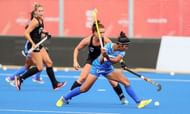The Indian women’s hockey team, led by Rani Rampal, have concluded their tour of New Zealand with an emphatic win over the hosts. This win came the day after they defeated Great Britain. These two victories marked a comeback for the Indian team after back-to-back losses against New Zealand last month.
Overall, India played five matches in this tour and won three while losing two. However, one of those victories was against the New Zealand developmental squad and hence not of that great a value except for the technical inputs that it would have provided to the players and the coaching staff.
But the other matches also that India played were not against the top teams of the countries they represented. New Zealand and Great Britain both were busy with FIH Pro League Women’s competition and therefore, didn’t field their best sides. Keeping that in mind, this performance would appear less than satisfactory.

Still, one can’t be too harsh on the Indian eves. As the coach Sjoerd Marijne himself said after the second match against New Zealand, this tour, even for the Indian team, was more about testing different tactics and combinations, rather than looking only for positive results.
“Today we tried a few things on the defensive side and that allowed New Zealand to come in our circle and create opportunities but it's better to practice these variations now in the matches as this Tour is more about our preparations for the Olympic Games and see how we can be better,” Marijne revealed.
In fact, before leaving for New Zealand, Marijne had made it clear that this tour is part of the preparations for the Olympics later this year.

“I want to use this tour to create more competition within this group. Although we are taking a 20-member team, in some matches we will use 16 players because we play with 16 players at the Olympics and in some matches we will play 18 members. The players have to show their best and I want to see how they perform under pressure and stay in the right rhythm for matches.”
A thing to ponder
One thing that would bother, or at least slightly concern, the Indian team management is the lack of goals in the four matches against national sides. Considering that the teams fielded were not the best ones those countries had, they must surely have hoped for more goals. It would have been even more so due to India’s forward line being quite impressive.
But in all, India managed to score only five goals in four matches. Again, this could be due to the team not playing its usual aggressive style but instead giving chances to new players and also focusing more on different aspects of the game.

There are also a couple of players who, probably, had their reputations enhanced by this tour. Navneet Kaur scored a brace in the final match. This would increase her chances of getting more playtime in the coming months. The forward line of Rani, Lalremsiami, Navjot Kaur, Vandana Katariya, and Sharmila had been producing good results.
Navneet’s good form will add further depth to the team and will achieve Marijne’s stated goal of creating more competition in the team.
But India still have a long way to go before becoming a side that can be considered a likely medalist in Tokyo Olympics. Even if one ignores the mixed results of this tournament, the performance in the Olympic qualifiers against USA was a mixed bag too. The one thing that was most glaring in the second match of that tournament was the wobbliness in face of pressure exerted by the visiting team.
The big test

In a tournament like Olympics, when every match, not just the knockout ones, will have a lot riding on it, handling pressure and remaining calm will be very important. Netherlands are the undisputed leaders in women’s hockey at the moment but teams like New Zealand and Australia are also dangerous if one lets them take control of the match.
There is need for the defence to be ready right from the outset. If, however, early goals are conceded, the players have to be able to stay calm and composed. This is where the role of experienced players like Rani and Deep Grace Ekka becomes crucial. The former in the frontline and the latter in defence have to shepherd the youngsters in tough situations.
Sjoerd Marijne had made it clear in his interactions with the media that the main reason he didn’t want the Indian women’s team to take part in the Pro League was the lack of depth that could get exposed in a tournament like this.
Therefore, even if this tour hasn’t achieved the perfect results, by giving an opportunity to several players and getting them more match experience would help create good bench strength and smoothen the path of Indian women’s hockey in times to come, even beyond the Olympics.
